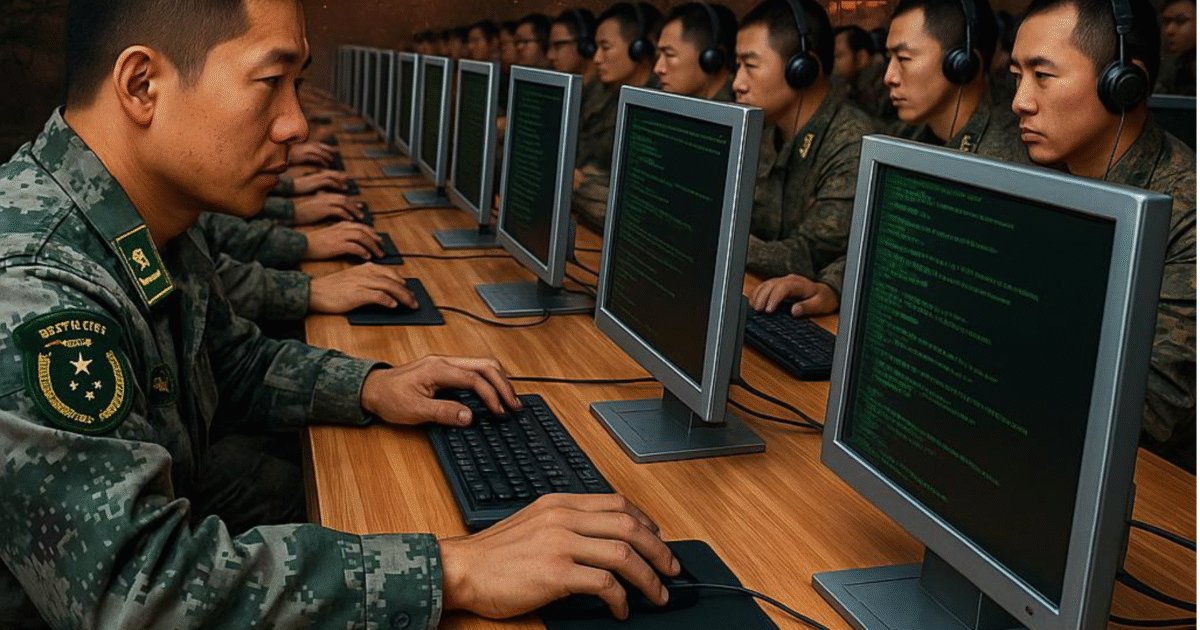China’s People’s Liberation Army (PLA) Unit 61398, based in Shanghai, has been publicly linked to extensive cyber-espionage operations targeting U.S. government agencies, defense contractors, and major corporations. Image generated by AI.
When wildfires swept across Maui, Hawaii, in August 2023, pro-China operatives launched an extensive disinformation campaign using AI-generated images and fabricated stories to claim that the U.S. military had used a “weather weapon” to start the fires. The operation involved at least 85 social media accounts and blogs traced to China, spreading content in 25 languages across platforms including Facebook, Twitter, YouTube, and numerous other sites.
Researchers from Microsoft, RAND Corporation, and other organizations confirmed that the campaign originated from China and represented one of the first known uses of artificial intelligence to enhance the realism and reach of a disinformation operation. The AI-generated images and narratives were designed to appear authentic, lending credibility to the false claim and helping it spread rapidly across multiple platforms and audiences.
The campaign’s goal was to sow division, distrust, and confusion among Americans. Hawaii Governor Josh Green reported that the false narratives claimed thousands of children were missing, undermining confidence in official rescue efforts.
Senator Mazie Hirono warned that foreign disinformation discouraged residents from seeking federal assistance, circulating false claims such as “Don’t sign up for FEMA because they cannot be trusted.” These narratives distracted emergency responders, deepened public anxiety, and hampered the government’s disaster relief operations.
This disinformation effort fit into a broader pattern of Chinese psychological and information warfare portraying the United States as a declining power. By amplifying tragedies in iconic American locations like Maui, Chinese propaganda sought to reinforce an image of U.S. incompetence, moral decay, and systemic collapse.
These tactics reflect China’s adoption of “dissipative warfare,” a modernized strategic framework for the age of artificial intelligence. Rather than pursuing direct military confrontation or large-scale battles, the strategy focuses on maintaining internal stability while creating systemic disorder in an adversary’s political, economic, and social systems.
Dissipative warfare builds upon the principles of “Unrestricted Warfare,” a doctrine articulated by PLA Colonels Qiao Liang and Wang Xiangsui that calls for using every instrument of national power, including cyberattacks, economic coercion, espionage, and disinformation, to achieve strategic objectives outside conventional warfare.
The approach emphasizes information dominance, intelligent algorithms, and systemic disruption to achieve asymmetric paralysis, disabling an opponent’s decision-making, communication, and defense systems without physical conflict. Drawing from concepts in physics, the theory views warfare as an energy system in which victory depends on maintaining internal order while increasing the enemy’s entropy, or chaos.
Not all dissipative warfare involves disinformation. A significant component focuses on data theft and exploitation through state-sponsored breaches and hacks, followed by the use of AI to build massive databases that support the Chinese Communist Party’s strategic objectives. In 2015, Chinese state-sponsored hackers carried out one of the largest breaches in U.S. history, targeting the U.S. government’s Office of Personnel Management.
Approximately 22.1 million records were compromised, including names, Social Security numbers, dates and places of birth, addresses, phone numbers, digital fingerprint images (5.6 million sets), and SF-86 security clearance forms containing decades of personal and professional data.
Biometrics experts warned that the stolen fingerprints meant undercover agents could no longer safely assume new identities. The breach made it possible to identify CIA officers operating abroad, track intelligence personnel through biometric databases at airports and border crossings, and reveal which diplomats were intelligence officers.
The SF-86 data included financial histories, foreign contacts, family information, travel records, and mental health details, making it easier to identify Americans who could be recruited or blackmailed. Individuals with gambling debts, financial stress, or sensitive personal information could be targeted, and family members or foreign contacts could be exploited for pressure or leverage.
The stolen information also enables what analysts call “trust attacks.” Because background investigation data often overlaps with answers to security questions, this information could be used to access or disable financial, medical, and social media accounts. Such attacks could create fear and mistrust among U.S. military and intelligence personnel through altered records, leaked private data, or fabricated online evidence of misconduct.
The OPM breach was only one part of a much larger campaign. Chinese hackers linked to intelligence services also compromised Anthem (78 million health records), Marriott (383 million guest records), Equifax (147 million credit reports), and databases belonging to the U.S. Navy and major airlines. By combining these datasets, AI can cross-reference individuals’ personal details, such as medical conditions, debts, travel patterns, and professional roles, to identify potential targets.
The use of AI multiplies the danger. What once would have required thousands of analysts can now be achieved in days. Pattern recognition and predictive analytics allow Chinese intelligence to identify vulnerabilities, forecast which officials may rise to key positions, and conduct personalized influence or recruitment operations at scale.
These and similar disinformation campaigns and data breaches demonstrate that China is already engaged in dissipative warfare against the United States, suggesting that the U.S. should view China as an adversary rather than merely a competitor.
The post Maui Wildfires Disinformation – China Already Waging ‘Dissipative Warfare’ Against the US appeared first on The Gateway Pundit.











